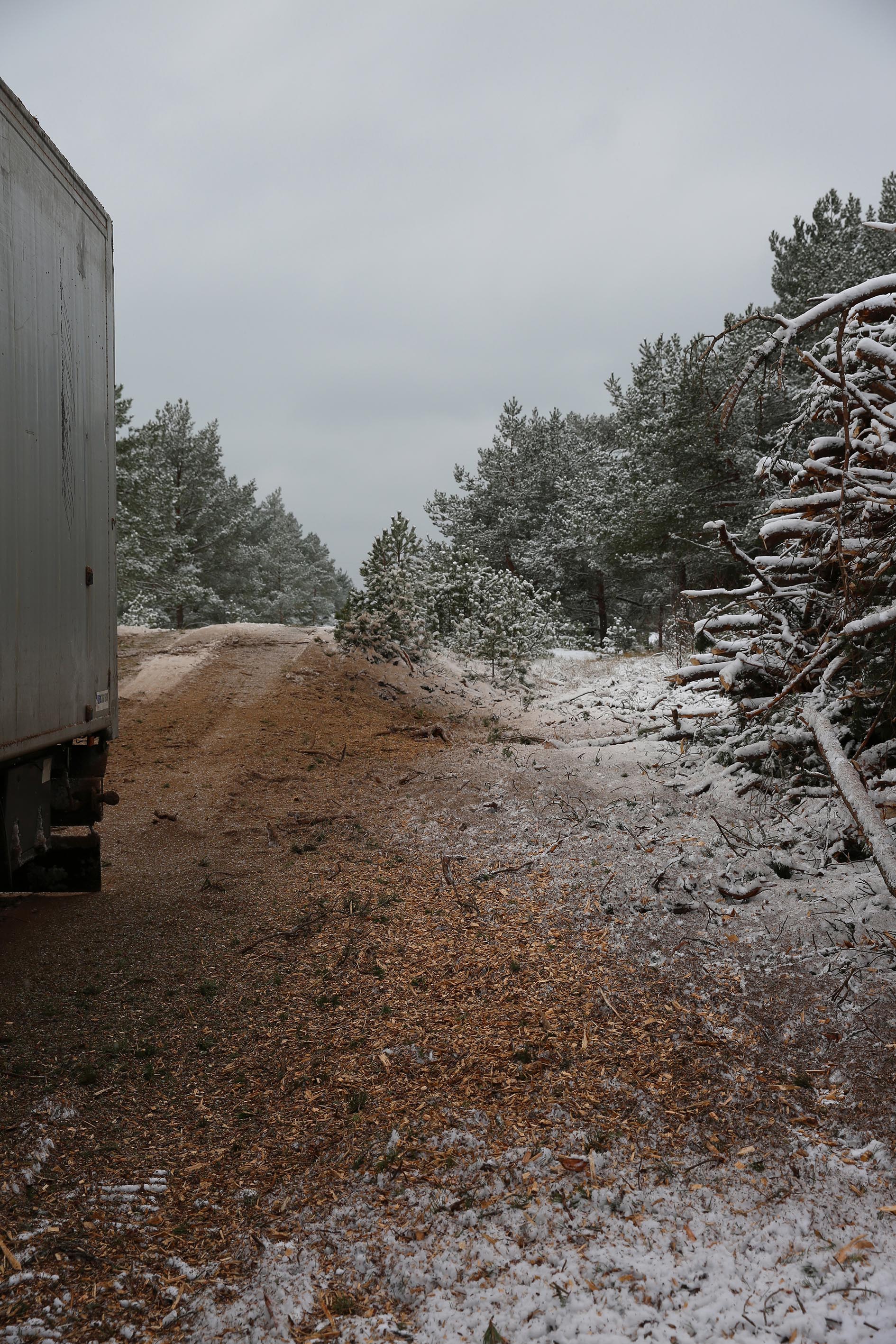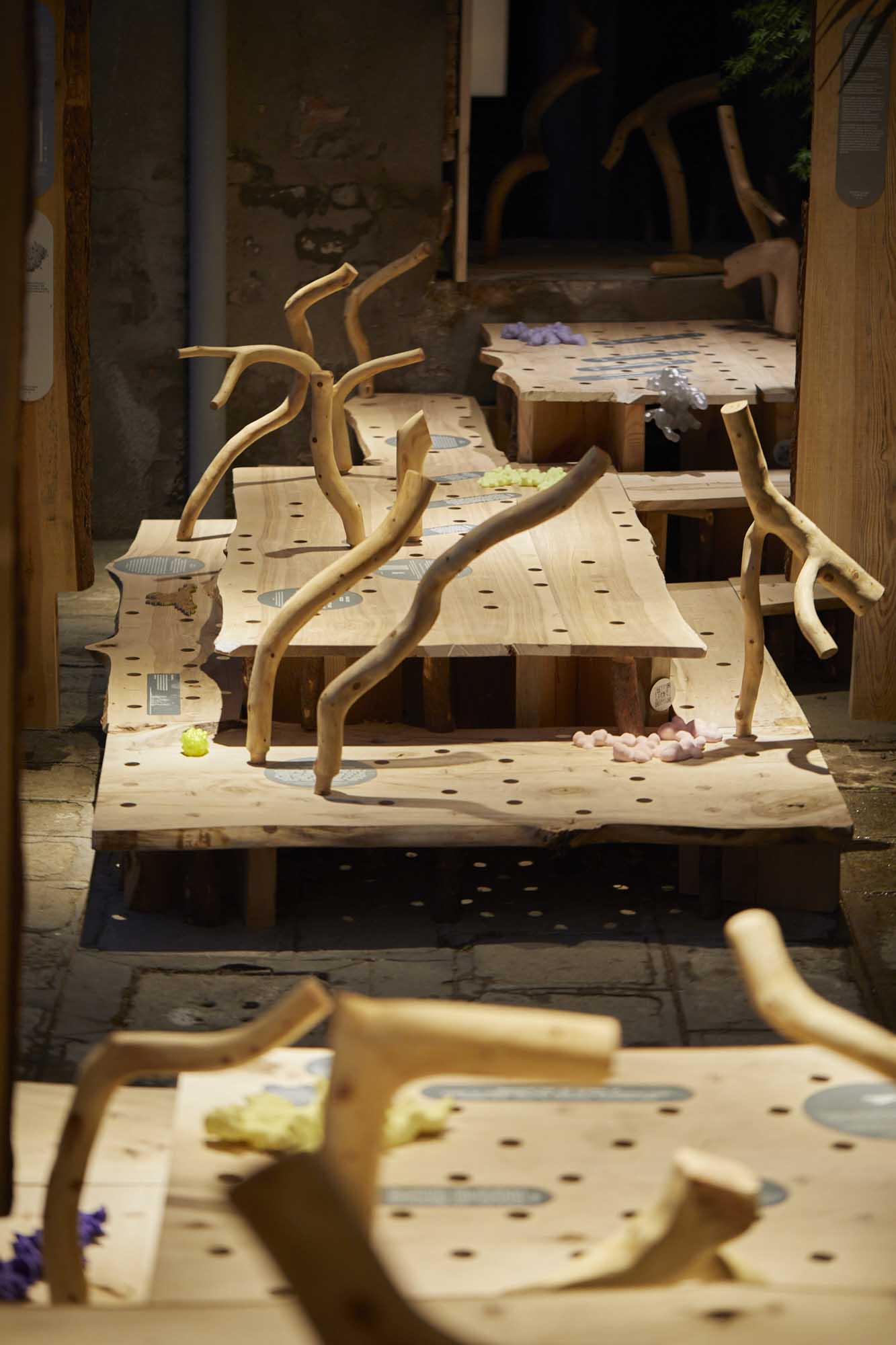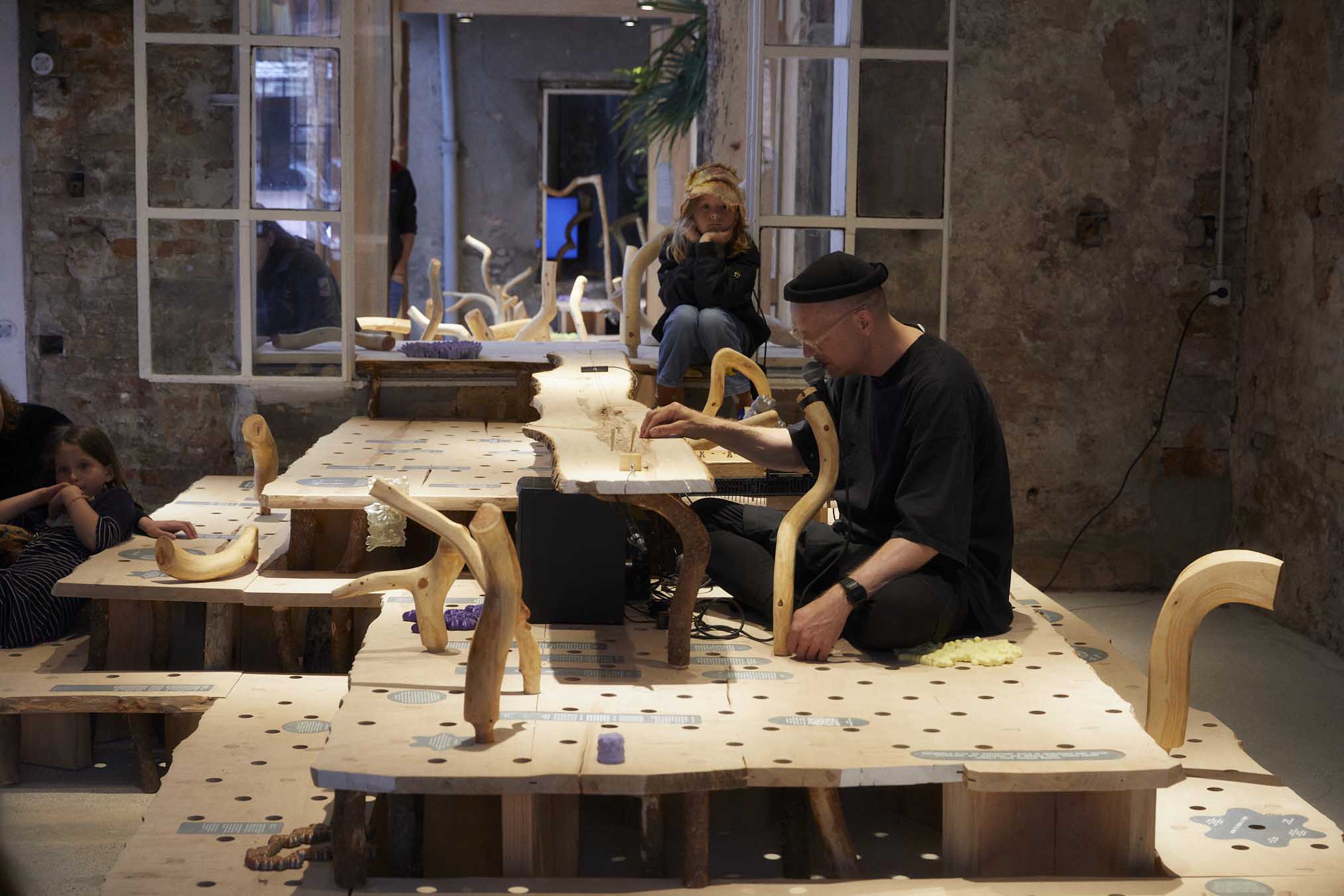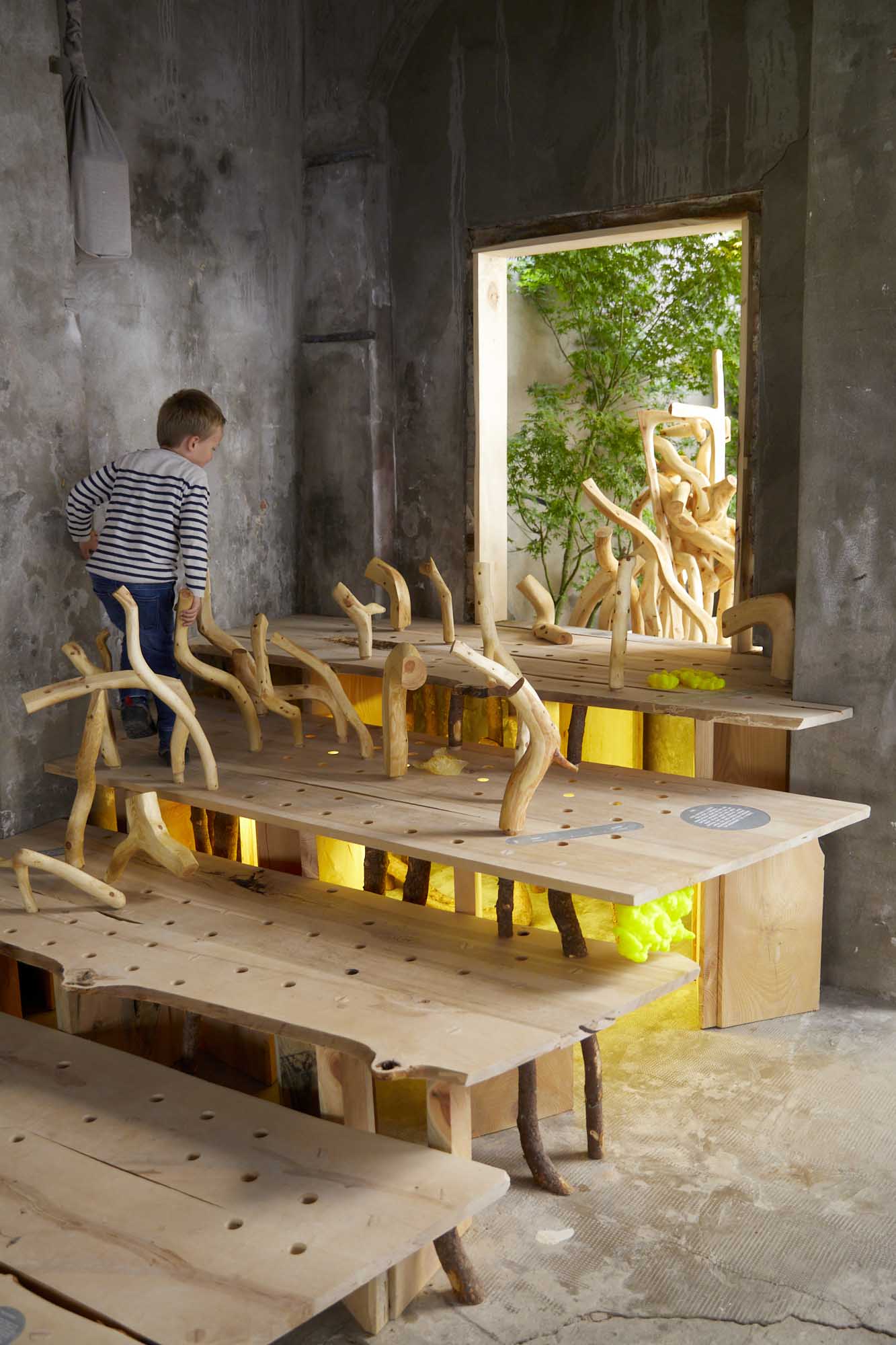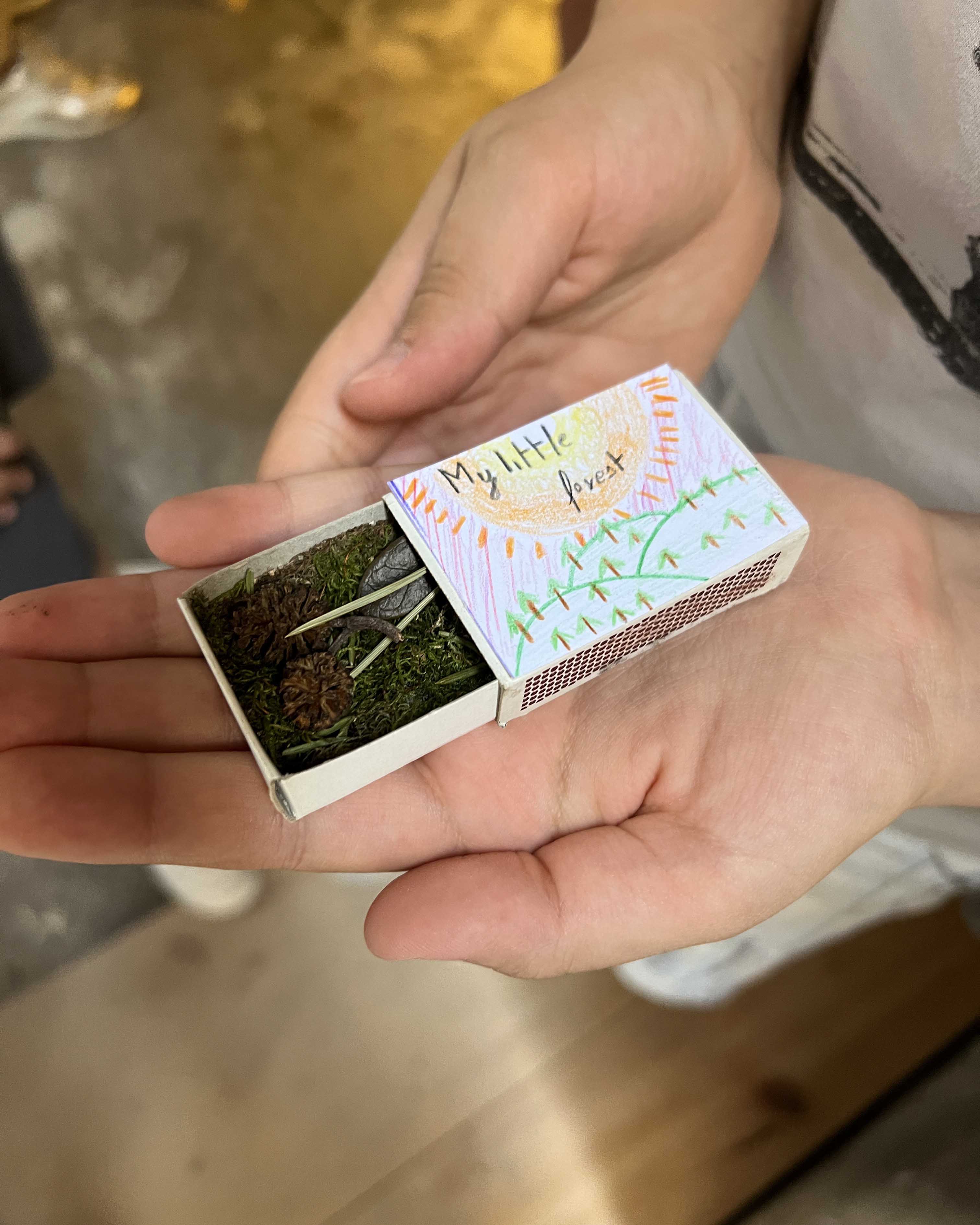Reconnecting with nature
Neringa Forest Architecture
Neringa Forest Architecture – Cultural Residency, Timber Seasoning Shed + Children’s Forest Pavilion
Neringa Forest Architecture is a cultural platform to interrelate extraction, biodiversity, and sustainability in the forest space through cultural and architectural praxis to enhance the ways society senses, understands, and negotiates processes in the forest environment. It investigates the cultural landscape of the Curonian Spit forests as a case study in the context of the wider region, considering the entanglement of ecologies, representations, colonial and industrial narratives.
EU Member State, Western Balkans or Ukraine
Lithuania
National
Yes
Lithuania- Vidurio ir vakarų Lietuvos regionas
No
Mainly rural
It refers to other types of transformations (soft investment)
Yes
2023-11-09
No
No
No
As a representative of an organisation
Neringa Forest Architecture is a cultural platform and design collective that works to interrelate extraction, biodiversity, and sustainability in the forest space by focusing on the agency of culture to enhance the ways society senses, reflects, and negotiates processes in the forest environment.
NFA's residency program at NAC assembles a community of architects, artists, and researchers to reflect on the interests, processes and causalities that shape the forest environment. The project reads the cultural landscape of Curonian Spit forest as a case study in the context of the wider region, considering the entanglement of ecologies, representations, colonial and industrial narratives. It collaborates with the Curonian Spit National Park, Neringa Municipality, State Forestry responsible for maintaining this UNESCO world heritage site and other organisations such as Mustarinda association, Ancient Woods Foundation among others.
The NFA started by diverting timber extracted in the Curonian Spit forest from becoming biofuel and built a Natural Timber Seasoning Shed at Nida Art Colony (NAC) of Vilnius Academy of Arts in Nida, it serves as an archive, documenting timber samples, a resource storage and public display of forest histories and planning.
From timber collected over three years, In 2023, NFA built and curated The Children’s Forest Pavilion installation composed as an educational playscape and conceived to acknowledge the unique approaches of children to observe, draw conclusions, explain the forest, and demand agency in forming it. This installation brings together works and findings developed in parallel to outdoor activities held with children in woodlands in Lithuania and Finland. Guided by environmental educators, activists, artists, architects, and foresters, they were introduced to think of forests as negotiated spaces where no single actor has a central stake.
NFA's residency program at NAC assembles a community of architects, artists, and researchers to reflect on the interests, processes and causalities that shape the forest environment. The project reads the cultural landscape of Curonian Spit forest as a case study in the context of the wider region, considering the entanglement of ecologies, representations, colonial and industrial narratives. It collaborates with the Curonian Spit National Park, Neringa Municipality, State Forestry responsible for maintaining this UNESCO world heritage site and other organisations such as Mustarinda association, Ancient Woods Foundation among others.
The NFA started by diverting timber extracted in the Curonian Spit forest from becoming biofuel and built a Natural Timber Seasoning Shed at Nida Art Colony (NAC) of Vilnius Academy of Arts in Nida, it serves as an archive, documenting timber samples, a resource storage and public display of forest histories and planning.
From timber collected over three years, In 2023, NFA built and curated The Children’s Forest Pavilion installation composed as an educational playscape and conceived to acknowledge the unique approaches of children to observe, draw conclusions, explain the forest, and demand agency in forming it. This installation brings together works and findings developed in parallel to outdoor activities held with children in woodlands in Lithuania and Finland. Guided by environmental educators, activists, artists, architects, and foresters, they were introduced to think of forests as negotiated spaces where no single actor has a central stake.
Forest
Culture
Pedagogy
Architecture
Biodiversity
Neringa Forest Architecture (NFA) relates extraction, biodiversity conservation, and cultural practices within the forest space challenging conventional notions of sustainability.
Timber Repurposing: Timber, initially designated for biofuel, not suitable for industrial use due to its intricate geometries, is made available for design practices to showcase possible aesthetics of sustainability.
Awareness through culture: The project acts as a cultural platform, involving architects, artists, researchers, and journalists in a residency program. The assembly promotes an enhanced understanding of the forest environment, by tracing its extractivist industrial practices and processes and their impact on biodiversity – engagement aims to offer wider public awareness of contemporary forest.
Collaborative Partnerships: NFA collaborates with various entities responsible for forest management, extraction and campaigning for biodiversity to initiate collaborations and design processes that involve contradicting positions in holistic approach to forest resources.
Design: The Timber Seasoning Shed at NAC in Nida, The Children’s Forest Pavilion, representing Lithuania at the Architecture Biennale are designed to engage the public with cultural practices which reflect human impact on forest and its long-term effects that includes all life forms and interests.
Long-Term and Education: the curated content highlights the importance of education in knowledge transfer and environmental literacy. Exploration of extractivist practices and uncovering the biodiversity in exhibitions, events, workshops and walks promotes understanding complex forces shaping forest space in the long-term.
Archive and Documentation: The Natural Timber Seasoning Shed serves as an archive documenting species of timber and forest processes, afforestation, and logging. This record promotes transparency and understanding, contributing to informing and involving the local community in decision making.
Timber Repurposing: Timber, initially designated for biofuel, not suitable for industrial use due to its intricate geometries, is made available for design practices to showcase possible aesthetics of sustainability.
Awareness through culture: The project acts as a cultural platform, involving architects, artists, researchers, and journalists in a residency program. The assembly promotes an enhanced understanding of the forest environment, by tracing its extractivist industrial practices and processes and their impact on biodiversity – engagement aims to offer wider public awareness of contemporary forest.
Collaborative Partnerships: NFA collaborates with various entities responsible for forest management, extraction and campaigning for biodiversity to initiate collaborations and design processes that involve contradicting positions in holistic approach to forest resources.
Design: The Timber Seasoning Shed at NAC in Nida, The Children’s Forest Pavilion, representing Lithuania at the Architecture Biennale are designed to engage the public with cultural practices which reflect human impact on forest and its long-term effects that includes all life forms and interests.
Long-Term and Education: the curated content highlights the importance of education in knowledge transfer and environmental literacy. Exploration of extractivist practices and uncovering the biodiversity in exhibitions, events, workshops and walks promotes understanding complex forces shaping forest space in the long-term.
Archive and Documentation: The Natural Timber Seasoning Shed serves as an archive documenting species of timber and forest processes, afforestation, and logging. This record promotes transparency and understanding, contributing to informing and involving the local community in decision making.
NFA forms cultural engagement, collaborative partnerships, and educational activities by curating ways culture practices are presented and at the same time designing spaces using timber resources that are addressed.
The project showcases intricate timber geometries, initially deemed unsuitable for industrial use, can be transformed into aesthetically pleasing and sustainable designs. This process redefines societal perceptions of what constitutes valuable and usable timber.
Through its residency program involving architects, artists and researchers NFA creates an immersive cultural experience. This dynamic community traces industrial practices, fostering a deeper appreciation for the forest. The project contributes to broader public awareness of the forest and its complexities, elevating the cultural discourse around environmental sustainability.
NFA's collaborative efforts exemplify how design can navigate contradictory positions, emphasising a holistic approach to forest resources. By engaging with various stakeholders, the project becomes a model for fostering collaboration in addressing complex ecological and cultural challenges.
The design provides a tangible connection between the public and cultural practices for reflection on the human impact on forests, and the approach exemplifies how architectural form may highlight environmental responsibility.
Curated content and educational initiatives convey the complex forces shaping forest spaces. By promoting knowledge transfer and environmental literacy, the project seeks lasting impact on how people perceive and engage with forests. This educational model sets a precedent for projects aspiring to instil a sense of responsibility and environmental consciousness.
Neringa Forest Architecture merges aesthetics, cultural engagement, collaborative partnerships, and education to redefine the quality and aesthetics associated with sustainable design and cultural initiatives in forest spaces.
The project showcases intricate timber geometries, initially deemed unsuitable for industrial use, can be transformed into aesthetically pleasing and sustainable designs. This process redefines societal perceptions of what constitutes valuable and usable timber.
Through its residency program involving architects, artists and researchers NFA creates an immersive cultural experience. This dynamic community traces industrial practices, fostering a deeper appreciation for the forest. The project contributes to broader public awareness of the forest and its complexities, elevating the cultural discourse around environmental sustainability.
NFA's collaborative efforts exemplify how design can navigate contradictory positions, emphasising a holistic approach to forest resources. By engaging with various stakeholders, the project becomes a model for fostering collaboration in addressing complex ecological and cultural challenges.
The design provides a tangible connection between the public and cultural practices for reflection on the human impact on forests, and the approach exemplifies how architectural form may highlight environmental responsibility.
Curated content and educational initiatives convey the complex forces shaping forest spaces. By promoting knowledge transfer and environmental literacy, the project seeks lasting impact on how people perceive and engage with forests. This educational model sets a precedent for projects aspiring to instil a sense of responsibility and environmental consciousness.
Neringa Forest Architecture merges aesthetics, cultural engagement, collaborative partnerships, and education to redefine the quality and aesthetics associated with sustainable design and cultural initiatives in forest spaces.
Neringa Forest Architecture (NFA) is committed to use of culture infrastructure such as arts funding, art institutions to directly address questions of sustainability, education, activism, role of design and architecture by focusing on questions of environmental relationships, responsibilities and impact of human activities in forest environment.
Project actively encourages participation from various socio-economic backgrounds, it serves as a cultural platform accessible to all, bridging gaps and creating an inclusive space for dialogue about forests and sustainability.
The design of structures like the Children’s Forest Pavilion exemplifies inclusivity. By incorporating diverse perspectives, especially those of children, the project ensures that the forest experience is accessible and engaging for all age groups.
NFA prioritises open and free access to educational materials, exhibitions, initiatives, such as workshops, walks, and educational events enabling a diverse audience to participate.
By involving stakeholders with varied interests, the project seeks to contribute to sustainable policies, inclusive decision-making that enhances the inclusiveness of forest management.
NFA's collaborative and interdisciplinary approach fosters models that go beyond conventions. By integrating cultural, ecological, and societal aspects, the project considers how new models can emerge, accommodating diverse needs and perspectives while rearticulating the importance of sustainability.
The collaborative partnerships with local entities managing forests highlights the importance of community engagement, the project respects and promotes incorporation of local knowledge, fostering a sense of ownership among the community.
Neringa Forest Architecture is committed to inclusion, making cultural and educational experiences accessible, the project seeks to establish a blueprint for fostering diversity, equity, and environmental responsibility within the context of forest spaces.
Project actively encourages participation from various socio-economic backgrounds, it serves as a cultural platform accessible to all, bridging gaps and creating an inclusive space for dialogue about forests and sustainability.
The design of structures like the Children’s Forest Pavilion exemplifies inclusivity. By incorporating diverse perspectives, especially those of children, the project ensures that the forest experience is accessible and engaging for all age groups.
NFA prioritises open and free access to educational materials, exhibitions, initiatives, such as workshops, walks, and educational events enabling a diverse audience to participate.
By involving stakeholders with varied interests, the project seeks to contribute to sustainable policies, inclusive decision-making that enhances the inclusiveness of forest management.
NFA's collaborative and interdisciplinary approach fosters models that go beyond conventions. By integrating cultural, ecological, and societal aspects, the project considers how new models can emerge, accommodating diverse needs and perspectives while rearticulating the importance of sustainability.
The collaborative partnerships with local entities managing forests highlights the importance of community engagement, the project respects and promotes incorporation of local knowledge, fostering a sense of ownership among the community.
Neringa Forest Architecture is committed to inclusion, making cultural and educational experiences accessible, the project seeks to establish a blueprint for fostering diversity, equity, and environmental responsibility within the context of forest spaces.
The engagement with the Local Community reflects the perspectives and concerns of those directly impacted by forest management, histories, cultural narratives and forest management plans that actively reshape the cultural landscape of the Curonian Spit forest not as timber resource plantation, but as recreational ground and UNESCO heritage site managed with recreational considerations and preservation of particular species diverse habitats and ecosystems. Such engagement involves workshops and organised walks in local forests to discover processes and management works to consider their impacts and long-term meanings.
By involving citizens in educational activities, NFA empowers them to understand the complexities of the forest space to participate in discussions about forest practices, sustainability, and cultural narratives. This exchange of ideas brings diverse perspectives into the conversation. It creates an open forum where citizens contribute to shaping the narrative around the forest and its significance.
Public awareness is heightened through tangible displays and documentation in structures like the Natural Timber Seasoning Shed. This display seeks to prompt informed decision-making regarding future forest management. NFA incorporates diverse perspectives, including those of children, in the design of structure of the Children’s Forest Pavilion, this participatory design approach ensures that the forest experience is accessible and engaging for everyone, fostering a sense of belonging and shared ownership.
Citizens and civil society are not mere recipients but active contributors to Neringa Forest Architecture; their involvement has shaped the project's critical understanding on how the culture practices and culture institutions may be more involved in addressing broader environmental concerns.
By involving citizens in educational activities, NFA empowers them to understand the complexities of the forest space to participate in discussions about forest practices, sustainability, and cultural narratives. This exchange of ideas brings diverse perspectives into the conversation. It creates an open forum where citizens contribute to shaping the narrative around the forest and its significance.
Public awareness is heightened through tangible displays and documentation in structures like the Natural Timber Seasoning Shed. This display seeks to prompt informed decision-making regarding future forest management. NFA incorporates diverse perspectives, including those of children, in the design of structure of the Children’s Forest Pavilion, this participatory design approach ensures that the forest experience is accessible and engaging for everyone, fostering a sense of belonging and shared ownership.
Citizens and civil society are not mere recipients but active contributors to Neringa Forest Architecture; their involvement has shaped the project's critical understanding on how the culture practices and culture institutions may be more involved in addressing broader environmental concerns.
Neringa Forest Architecture is committed to comprehensive engagement, involving stakeholders at local, regional, national, and European levels.
Local Stakeholders: Curonian Spit residents, and local authorities are integral project stakeholders. Workshops and walks offer a space for dialogue, transforming local insights into actionable design elements.
Regional and National Collaborations: Collaborations with Curonian Spit National Park, State Forestry and Vilnius Academy of Arts (VAA) roles extend to regulatory insights both of forestry regulation and role of culture education, allowing NFA to align the project to consider the concepts and aesthetics of sustainability practices in relation to industrial processes.
- Representing Lithuania at the Venice Architecture Biennale broadens the project's impact by fostering international dialogue on a European level, adding credibility and setting a precedent for cross-cultural initiatives. The project showcases how local endeavours can align with broader discussions in the field of architecture and its relation to design of sustainable spatial products. The Children’s Forest Pavilion at the Venice Architecture Biennale received over 30,000 visitors during the exhibition. Participation led to multiple further conversations and possible collaborations with other institutions such as arc en rêve centre for architecture in Bordeaux France that might lead to an exploration and case study of forests in France and possible exhibition in coming years.
- By engaging with environmental advocacy groups such as the Ancient Woods Foundation and Mustarinda association, NFA incorporates scientific perspectives into its narrative. The project's alignment with ecological preservation promotes critical discourse on sustainable forest practices.
Partnerships with educational institutions allows us to consider the role of education in promoting wider understanding of environmental relationships, responsibilities and negotiations.
Local Stakeholders: Curonian Spit residents, and local authorities are integral project stakeholders. Workshops and walks offer a space for dialogue, transforming local insights into actionable design elements.
Regional and National Collaborations: Collaborations with Curonian Spit National Park, State Forestry and Vilnius Academy of Arts (VAA) roles extend to regulatory insights both of forestry regulation and role of culture education, allowing NFA to align the project to consider the concepts and aesthetics of sustainability practices in relation to industrial processes.
- Representing Lithuania at the Venice Architecture Biennale broadens the project's impact by fostering international dialogue on a European level, adding credibility and setting a precedent for cross-cultural initiatives. The project showcases how local endeavours can align with broader discussions in the field of architecture and its relation to design of sustainable spatial products. The Children’s Forest Pavilion at the Venice Architecture Biennale received over 30,000 visitors during the exhibition. Participation led to multiple further conversations and possible collaborations with other institutions such as arc en rêve centre for architecture in Bordeaux France that might lead to an exploration and case study of forests in France and possible exhibition in coming years.
- By engaging with environmental advocacy groups such as the Ancient Woods Foundation and Mustarinda association, NFA incorporates scientific perspectives into its narrative. The project's alignment with ecological preservation promotes critical discourse on sustainable forest practices.
Partnerships with educational institutions allows us to consider the role of education in promoting wider understanding of environmental relationships, responsibilities and negotiations.
The pile of timber becomes a signifier for shared knowledge and further debate on environmental relationships and cultural practices in the intersection of politics and technology.
The project’s aim is to think of culture as an active agent in relation to scientific research, innovation and industry active in forming the idea of “what is a forest”. The project connects to social sectors responsible for policy-making principles and objectives in public administrations and seeks collaborations among different departments, and across levels, in order to look into policies regulating forestry, timber and forest product industries and technologies.
NFA involves an intersectoral approach, integrating various fields of knowledge to bring together environmental educators, activists, artists, architects, researchers and foresters to think of forests as negotiated spaces where no single actor has a central stake. Field research visits to different landscapes, types of woodland, timber industries and research establishments allowed us to re-constitute images and concepts of the forest, to see the ways the forest industries formed the landscapes, utilised waterways and reshaped the forests. We are thinking on how these entanglements could be reworked in order to ensure biodiversity and how culture could be used to re-assemble imagination relating societies to the environment.
The NFA have worked with forest architectural researchers, artists, educators, and architects to reflect on the impact of extraction practices on the ecosystem of forest. Project collaborators evolved a methodologies encompassing architectural research and design as well as carpentry, walks organised in collaboration with local foresters, landscape planners and architects, publishing practices, and institutional engagement. The approach extends its impact both within the local context and on an international scale.
The project’s aim is to think of culture as an active agent in relation to scientific research, innovation and industry active in forming the idea of “what is a forest”. The project connects to social sectors responsible for policy-making principles and objectives in public administrations and seeks collaborations among different departments, and across levels, in order to look into policies regulating forestry, timber and forest product industries and technologies.
NFA involves an intersectoral approach, integrating various fields of knowledge to bring together environmental educators, activists, artists, architects, researchers and foresters to think of forests as negotiated spaces where no single actor has a central stake. Field research visits to different landscapes, types of woodland, timber industries and research establishments allowed us to re-constitute images and concepts of the forest, to see the ways the forest industries formed the landscapes, utilised waterways and reshaped the forests. We are thinking on how these entanglements could be reworked in order to ensure biodiversity and how culture could be used to re-assemble imagination relating societies to the environment.
The NFA have worked with forest architectural researchers, artists, educators, and architects to reflect on the impact of extraction practices on the ecosystem of forest. Project collaborators evolved a methodologies encompassing architectural research and design as well as carpentry, walks organised in collaboration with local foresters, landscape planners and architects, publishing practices, and institutional engagement. The approach extends its impact both within the local context and on an international scale.
Neringa Forest Architecture (NFA) introduces a cultural platform to interweave extraction, biodiversity, and sustainability in contrast to conventional practices within the forest domain.
The innovative character of NFA lies in its multifaceted exploration of the cultural landscape of Curonian Spit forests, as a case study to unravel the complex interplay of ecologies, representations, and historical narratives. Unlike mainstream actions, NFA positions culture as a pivotal force, influencing societal perception, understanding, and negotiation of processes within the forest environment.
By diverting timber originally intended for biofuel to construct the Natural Timber Seasoning Shed, NFA challenges mainstream norms by repurposing intricate geometries deemed unsuitable for industrial use. This not only showcases a novel approach to timber utilization but also redefines aesthetics in sustainable design practices.
The project's residency program, involving architects, artists, and researchers, further sets it apart. This collaborative platform engages diverse voices, deviating from traditional practices, fostering a richer understanding of the forest environment. NFA's collaboration with various entities responsible for forest management and biodiversity conservation showcases an innovative approach, emphasizing negotiation, contradiction, and a holistic perspective.
The Children’s Forest Pavilion, representing Lithuania at the Architecture Biennale , is a testament to NFA's innovative narrative. By acknowledging the unique perspectives of children in understanding and interacting with the forest, the project diverges from conventional approaches, offering a fresh and inclusive outlook.
In essence, Neringa Forest Architecture challenges mainstream practices by placing culture at the forefront, repurposing timber creatively, fostering diverse collaborations, and embracing the unique viewpoints of children, thus exemplifying an innovative paradigm within the field.
The innovative character of NFA lies in its multifaceted exploration of the cultural landscape of Curonian Spit forests, as a case study to unravel the complex interplay of ecologies, representations, and historical narratives. Unlike mainstream actions, NFA positions culture as a pivotal force, influencing societal perception, understanding, and negotiation of processes within the forest environment.
By diverting timber originally intended for biofuel to construct the Natural Timber Seasoning Shed, NFA challenges mainstream norms by repurposing intricate geometries deemed unsuitable for industrial use. This not only showcases a novel approach to timber utilization but also redefines aesthetics in sustainable design practices.
The project's residency program, involving architects, artists, and researchers, further sets it apart. This collaborative platform engages diverse voices, deviating from traditional practices, fostering a richer understanding of the forest environment. NFA's collaboration with various entities responsible for forest management and biodiversity conservation showcases an innovative approach, emphasizing negotiation, contradiction, and a holistic perspective.
The Children’s Forest Pavilion, representing Lithuania at the Architecture Biennale , is a testament to NFA's innovative narrative. By acknowledging the unique perspectives of children in understanding and interacting with the forest, the project diverges from conventional approaches, offering a fresh and inclusive outlook.
In essence, Neringa Forest Architecture challenges mainstream practices by placing culture at the forefront, repurposing timber creatively, fostering diverse collaborations, and embracing the unique viewpoints of children, thus exemplifying an innovative paradigm within the field.
NFA employs a multi-faceted methodology that integrates cultural practices, collaborative partnerships, and educational initiatives, creating a comprehensive approach in design and architecture. It is a cultural platform for architects, artists and researchers and a residency program.
The project challenges conventional norms by repurposing timber initially designated for biofuel. Timber with intricate geometries, deemed unsuitable for industry, is used to build structures like the Natural Timber Seasoning Shed and Educational Playscape for the Children’s Forest Pavilion.
Collaborative approach involves contradicting positions – communities, agencies and institutions who depend and are responsible for forest management, extraction, and biodiversity conservation are involved in knowledge sharing through workshops, walks, exhibitions, case studies, design and architecture projects.
By engaging stakeholders at various levels, from local to national and European, the project seeks to showcase diverse perspectives and promote an enhanced role of culture practices in inclusive decision-making in the management of forest spaces.
The project emphasises the importance of education in knowledge transfer and environmental literacy – NFA promotes nuanced understanding of the complexity of interests shaping forest spaces by embracing inclusivity, participatory design approach to ensure accessibility and engagement for all age groups. It leverages cultural practices, sustainable design, collaboration, education, and inclusivity while advocating for long-term balance between industrial extraction and biodiversity conservation.
The project challenges conventional norms by repurposing timber initially designated for biofuel. Timber with intricate geometries, deemed unsuitable for industry, is used to build structures like the Natural Timber Seasoning Shed and Educational Playscape for the Children’s Forest Pavilion.
Collaborative approach involves contradicting positions – communities, agencies and institutions who depend and are responsible for forest management, extraction, and biodiversity conservation are involved in knowledge sharing through workshops, walks, exhibitions, case studies, design and architecture projects.
By engaging stakeholders at various levels, from local to national and European, the project seeks to showcase diverse perspectives and promote an enhanced role of culture practices in inclusive decision-making in the management of forest spaces.
The project emphasises the importance of education in knowledge transfer and environmental literacy – NFA promotes nuanced understanding of the complexity of interests shaping forest spaces by embracing inclusivity, participatory design approach to ensure accessibility and engagement for all age groups. It leverages cultural practices, sustainable design, collaboration, education, and inclusivity while advocating for long-term balance between industrial extraction and biodiversity conservation.
The residency program and cultural engagement methodology can be adapted to different landscapes and forest environments. By involving architects, artists, researchers, and journalists, communities elsewhere can benefit from a deeper understanding of their local forests.
In prevailing industrial methodologies timber with unusual methodologies gets directed to biofuel use which is not entirely sustainable practice, showcasing use of unconventional timber in design and architecture is transferable and scalable practice.
The model of collaborating with entities responsible for forest management, extraction, and biodiversity conservation is transferable. Negotiating contradicting positions and promoting a holistic understanding of forest resources can be adapted to different administrative structures and forest management practices, promoting inclusive decision-making.
The educational initiatives, including exhibitions, events, workshops, and walks, provide a replicable model for promoting environmental literacy. Adapting these initiatives to local contexts allows for the exploration of extractivist practices and the uncovering of biodiversity, fostering public awareness and engagement with forest.
The emphasis on inclusivity, participatory design, and creating spaces accessible to all age groups offers a blueprint for designing structures that engage communities with their natural surroundings.
Neringa Forest Architecture is a proposition and an experiment on interrelating cultural practices with challenges and complex negotiations in forest spaces, fostering a broader movement toward responsible and meaningful interaction with natural environments.
In prevailing industrial methodologies timber with unusual methodologies gets directed to biofuel use which is not entirely sustainable practice, showcasing use of unconventional timber in design and architecture is transferable and scalable practice.
The model of collaborating with entities responsible for forest management, extraction, and biodiversity conservation is transferable. Negotiating contradicting positions and promoting a holistic understanding of forest resources can be adapted to different administrative structures and forest management practices, promoting inclusive decision-making.
The educational initiatives, including exhibitions, events, workshops, and walks, provide a replicable model for promoting environmental literacy. Adapting these initiatives to local contexts allows for the exploration of extractivist practices and the uncovering of biodiversity, fostering public awareness and engagement with forest.
The emphasis on inclusivity, participatory design, and creating spaces accessible to all age groups offers a blueprint for designing structures that engage communities with their natural surroundings.
Neringa Forest Architecture is a proposition and an experiment on interrelating cultural practices with challenges and complex negotiations in forest spaces, fostering a broader movement toward responsible and meaningful interaction with natural environments.
The project responds to the global challenge of climate heating by promoting sustainable forest practices. Timber repurposing and the emphasis on aesthetics of unconventional timber provide a local solution that contributes to reducing reliance on traditional, less sustainable building materials.
The project's collaboration with various entities responsible for forest management and biodiversity conservation serves as a local model for addressing the global challenge of biodiversity loss. NFA's cultural engagement initiatives foster local solutions for enhancing environmental and cultural awareness. By involving diverse stakeholders, including artists, architects, researchers, and local communities, the project proposes a cultural platform that may serve as a template for reconnecting societies with their natural environments and promoting a sense of responsibility for the ecosystems they inhabit.
NFA experiments with a participatory approach to decision-making. This local solution encourages more inclusive governance structures for sustainable forest management.
Through exhibitions, workshops, and walks, the project promotes understanding of complex forces shaping forest spaces. This localised educational model is transferable and can be applied to bridge gaps in environmental knowledge and promote sustainable practices.
The project's participation in international forums, such as the Venice Architecture Biennale, facilitates cross-cultural dialogue on forest environments and encourages addressing common environmental concerns.
The project's collaboration with various entities responsible for forest management and biodiversity conservation serves as a local model for addressing the global challenge of biodiversity loss. NFA's cultural engagement initiatives foster local solutions for enhancing environmental and cultural awareness. By involving diverse stakeholders, including artists, architects, researchers, and local communities, the project proposes a cultural platform that may serve as a template for reconnecting societies with their natural environments and promoting a sense of responsibility for the ecosystems they inhabit.
NFA experiments with a participatory approach to decision-making. This local solution encourages more inclusive governance structures for sustainable forest management.
Through exhibitions, workshops, and walks, the project promotes understanding of complex forces shaping forest spaces. This localised educational model is transferable and can be applied to bridge gaps in environmental knowledge and promote sustainable practices.
The project's participation in international forums, such as the Venice Architecture Biennale, facilitates cross-cultural dialogue on forest environments and encourages addressing common environmental concerns.
Diverting timber initially designated for biofuel allowed creation of architecture that challenges traditional perceptions of sustainability, this impact extends to the general public engaging with the designs.
Residency program involving architects, artists, researchers, and journalists enhanced understanding of the forest environment and its extractivist practices and raised cultural and environmental awareness within the community and the wider public.
Collaboration with entities responsible for forest management and biodiversity conservation initiated partnerships and negotiations between stakeholders to influence forest management practices. This impact directly benefits the local community, foresters, and organizations involved.
Development of educational content, including exhibitions, events, workshops, publications and walks promoted environmental literacy and understanding of complex forces shaping forest spaces may lead to long-term impact on knowledge transfer, contributing to informed decision-making and heightened awareness.
The Natural Timber Seasoning Shed serves as a public display documenting timber species and forest processes promoting transparency and understanding of forest practices. It informs the community in decision-making on future forest management.
Design of the Children’s Forest Pavilion is focused on inclusivity, it created space for diverse age groups, including children. It fosters a sense of belonging and shared ownership, making cultural and educational experiences accessible to all.
Neringa Forest Architecture has achieved tangible results, impactful outcomes, and lasting benefits across sustainability, cultural engagement, education, and stakeholder collaboration. The direct beneficiaries include local communities, artists, architects, researchers, and children, with indirect benefits extending to the broader public and international stakeholders engaged in discussions on sustainable forest practices.
Residency program involving architects, artists, researchers, and journalists enhanced understanding of the forest environment and its extractivist practices and raised cultural and environmental awareness within the community and the wider public.
Collaboration with entities responsible for forest management and biodiversity conservation initiated partnerships and negotiations between stakeholders to influence forest management practices. This impact directly benefits the local community, foresters, and organizations involved.
Development of educational content, including exhibitions, events, workshops, publications and walks promoted environmental literacy and understanding of complex forces shaping forest spaces may lead to long-term impact on knowledge transfer, contributing to informed decision-making and heightened awareness.
The Natural Timber Seasoning Shed serves as a public display documenting timber species and forest processes promoting transparency and understanding of forest practices. It informs the community in decision-making on future forest management.
Design of the Children’s Forest Pavilion is focused on inclusivity, it created space for diverse age groups, including children. It fosters a sense of belonging and shared ownership, making cultural and educational experiences accessible to all.
Neringa Forest Architecture has achieved tangible results, impactful outcomes, and lasting benefits across sustainability, cultural engagement, education, and stakeholder collaboration. The direct beneficiaries include local communities, artists, architects, researchers, and children, with indirect benefits extending to the broader public and international stakeholders engaged in discussions on sustainable forest practices.
Both
- Downloadpdf-1-7234.pdf
{Empty}
Yes
Yes
Yes
Yes
Yes
Yes
Yes


